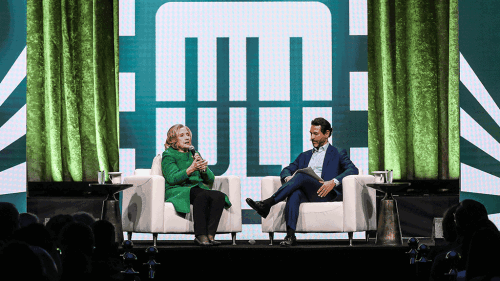Renewed optimism among small business owners, strong consumer confidence, and a robust U.S. job market suggest that the next recession may be further away than what economists predicted just a year ago.
“I think we still have two or three years to go yet, and that’s where I thought we were last year,” said economist Mark Dotzour, speaking at a ULI North Texas event in Dallas. Demographer Joel Kotkin of the Center for Opportunity Urbanism also named Dallas the top job market among large cities for 2017.
The rebounding U.S. energy industry is beginning to have a positive impact while continued demand for new single-family homes should buoy the economy and offset weakness in the automotive sector. However, constrained inventory and student loan debt persist as key challenges for the housing industry, he said.
Dotzour, a well-known real estate economist formerly affiliated with the Real Estate Center at Texas A&M University, gave the keynote at the event, which featured breakout sessions with panelists discussing the latest Dallas/Fort Worth trends for multifamily, retail, industrial, office, mixed-use, health care, hospitality, transit-oriented development, and single-family residential.
TOD Reaches $2 Billion-Dollar Mark
During a panel on transit-oriented development (TOD), speakers said that development around Dallas Area Rapid Transit (DART) stations is producing a sizable economic impact. In one of the most recent studies on the issue, covering 2014–2015, the authors looked at 27 projects that were completed, under construction, or planned within a quarter-mile (0.4 km) of Dallas transit stations.
The study determined that 16 completed or under-construction projects were responsible for $2.03 billion in total spending and supported more than 12,000 jobs over the two-year study window, said Michael Carroll, director of the Economics Research Group at the University of North Texas, and one of the study’s authors. These 16 projects accounted for an estimated $69 million in local and state taxes over two years.
Another 11 planned projects were expected to result in $5.1 billion of total spending in the region, supporting over 31,000 jobs, according to the study. The planned projects were projected to provide a potential $160 million in state and local taxes over a two-year period, he said.
The trend of developing real estate near transit stations is a nationwide phenomenon as connectivity and multimodal transportation become increasingly important for urban dwellers.
One of the largest transit-oriented redevelopments in Dallas is Victory Park. The 75-acre (30 ha) master-planned development, which includes a transit station, got its start during the 1980s after Ross Perot Jr.’s development company, Hillwood, assembled about 100 transactions in a site just northwest of downtown Dallas that contained an old rail yard, a power plant, and grain elevators.
A public/private partnership and city bond referendum provided funding for the construction of American Airlines Center, a popular arena that opened in 2001 and anchors the development. It is home to the National Basketball Association’s Dallas Mavericks and the National Hockey League’s Dallas Stars and regularly attracts big-name entertainers.
But Victory Park stumbled in the years after the arena was built. The original vision of corporate offices with sleek high-end retail and restaurants failed to materialize. The development took a pause in 2009 as the economy sputtered.
By 2012, developers were ready to give it another go, said Kyle Vinson, senior portfolio manager at Cushman & Wakefield and an adviser to Estein USA, which now owns a large swath of Victory, including office and retail space and vacant land parcels. The reboot underway began with an extensive study to determine what was needed to make he development succeed.
The study determined that the development needed to become more approachable and pedestrian friendly. Streets were narrowed while sidewalks were widened to create outdoor restaurant seating. A protected bike lane was added that ties into the Katy Trail, and two one-way streets through Victory were made into two-way streets to improve access. The stark concrete and glass development was also warmed up with trees, pavers, plantings, benches, and signage. Once-sleek storefronts are now individually designed to add character.
Still, Victory needed another anchor development to attract people when nothing was happening at the arena, Vinson said. That will come later this year or in early 2018, when Cinepolis, an eight-screen theater, opens.
Thousands of high-end multifamily apartments also are under construction nearby.
“We think this is a fantastic opportunity,” said Drew Steffen, managing director, Hines, whose company is building 365 luxury apartments in a 30-story building.
John Allums, division president at LMC, a Lennar company, said the area is experiencing “a residential explosion.” LMC is developing “Block G,” which will include the movie theater, retail, and 285 apartment units. It expects the first apartments to be occupied this fall.
Rethinking Single-Family Marketing
Homebuilders and developers on a community development panel talked about marketing new homes in the age of social media. The day of the “new home center” is gone, said Robert Kembel with the Nehemiah Co., which is developing the 2,000-acre (809 ha) Viridian master-planned project in nearby Arlington, Texas.
Not only are such information centers at the entrance of new home developments costly, but they are not applicable to today’s consumers who get from the internet much of the information that a developer would offer in such a center, he said.
“People are desperate for more time,” Kembel said. “We want to make their time efficient on how they get places and interact.” Marketing at Viridian includes content streamed on televisions in model homes about the community and its amenities and “lifestyle coordinators” who ask people touring models how they found out about the development to drive future marketing. Nehemiah has relied on mostly “old school” advertising as a result of those conversations: billboards, signage, and radio advertisements have been among the most effective in reaching prospective buyers, he said.






